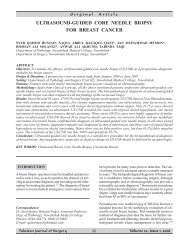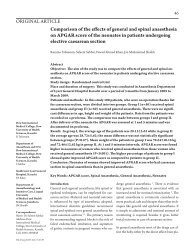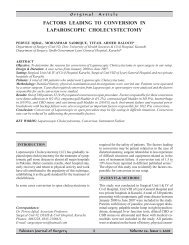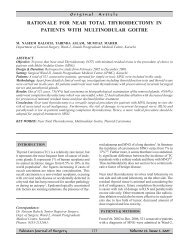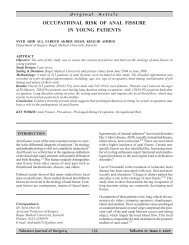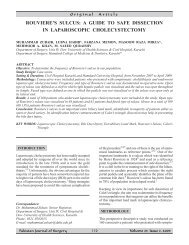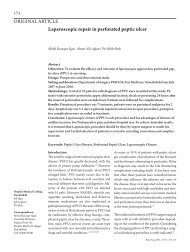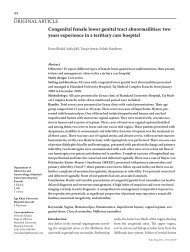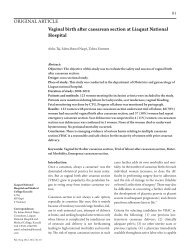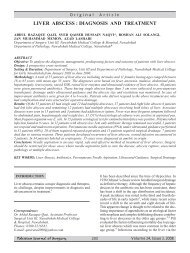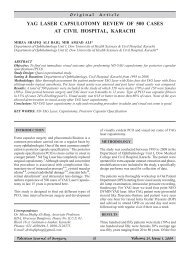Efficacy and safety of drotaverine and phloroglucinol in first stage of ...
Efficacy and safety of drotaverine and phloroglucinol in first stage of ...
Efficacy and safety of drotaverine and phloroglucinol in first stage of ...
Create successful ePaper yourself
Turn your PDF publications into a flip-book with our unique Google optimized e-Paper software.
ORIGINAL ARTICLE<strong>Efficacy</strong> <strong>and</strong> <strong>safety</strong> <strong>of</strong> <strong>drotaver<strong>in</strong>e</strong> <strong>and</strong> <strong>phlorogluc<strong>in</strong>ol</strong> <strong>in</strong><strong>first</strong> <strong>stage</strong> <strong>of</strong> labour39Salma Batool Naqvi, Zaib-Un-Nisa HaroonAbstractObjective: To compare the efficacy <strong>and</strong> <strong>safety</strong> <strong>of</strong> <strong>drotaver<strong>in</strong>e</strong> <strong>and</strong> Phlorogluc<strong>in</strong>ol <strong>in</strong> the duration<strong>of</strong> <strong>first</strong> <strong>stage</strong> <strong>of</strong> labour. Ma<strong>in</strong> outcome measure were duration <strong>of</strong> <strong>first</strong> <strong>stage</strong> <strong>of</strong> labour, rate<strong>of</strong> cervical dilatation, maternal <strong>and</strong> fetal side effects <strong>and</strong> mode <strong>of</strong> delivery. Student t- test appliedfor statistical analysis.Study design: R<strong>and</strong>omized controlled trial.Sett<strong>in</strong>g: Department <strong>of</strong> Obstetrics <strong>and</strong> Gynaecology, Liaquat National Hospital <strong>and</strong> MedicalCollege, Karachi, Pakistan.Subject: One hundred women <strong>in</strong> active phase <strong>of</strong> uncomplicated labour. 50 patients <strong>in</strong> evennumbers received <strong>phlorogluc<strong>in</strong>ol</strong> (group A) <strong>and</strong> 50 patients <strong>in</strong> odd numbers received <strong>drotaver<strong>in</strong>e</strong>(group B).Results: Both <strong>phlorogluc<strong>in</strong>ol</strong> <strong>and</strong> <strong>drotaver<strong>in</strong>e</strong> appears to be effective <strong>in</strong> the acceleration <strong>of</strong>labour but duration <strong>of</strong> <strong>first</strong> <strong>stage</strong> <strong>of</strong> labour was 46.85 m<strong>in</strong>utes (24.49%) shorter <strong>and</strong> cervicaldilatation 0.38 centimeters/ hour (15.32%) faster <strong>in</strong> <strong>phlorogluc<strong>in</strong>ol</strong> group as compare to<strong>drotaver<strong>in</strong>e</strong> group which was statistically significant (p< 0.05), no fetomaternal side effectsseen <strong>in</strong> <strong>phlorogluc<strong>in</strong>ol</strong> group but m<strong>in</strong>or side effects seen <strong>in</strong> <strong>drotaver<strong>in</strong>e</strong> group. No Caesareansection was required <strong>and</strong> less number <strong>of</strong> <strong>in</strong>jections required <strong>in</strong> <strong>phlorogluc<strong>in</strong>ol</strong> group. It alsohas analgesic effect.Conclusion: Both drugs are effective <strong>in</strong> acceleration <strong>of</strong> labour, however <strong>phlorogluc<strong>in</strong>ol</strong> ismore effective <strong>in</strong> shorten<strong>in</strong>g the total duration <strong>and</strong> <strong>first</strong> <strong>stage</strong> <strong>of</strong> labour <strong>and</strong> safe with n<strong>of</strong>etomaternal side effect, hav<strong>in</strong>g analgesic effect, less number <strong>of</strong> <strong>in</strong>jections required <strong>and</strong>, noCaesarean section required.Department <strong>of</strong>Obstetrics <strong>and</strong>GynaecologyLiaquat NationalHospital <strong>and</strong> MedicalCollegeKarachi – PakistanSB NaqviZN HaroonCorrespondence:Dr. Salma Batool NaqviConsultant, Department<strong>of</strong> Obstetrics <strong>and</strong>Gynaecology, LiaquatNational Hospital <strong>and</strong>Medical College, Karachi –PakistanCell: 0321 2546769Keywords: Phlorogluc<strong>in</strong>ol, Drotaver<strong>in</strong>e, <strong>Efficacy</strong>, Labour.Introduction:Labour is a multifactorial process which <strong>in</strong>volvesmyometrial contraction, cervical ripen<strong>in</strong>g <strong>and</strong>dilatation <strong>and</strong> the expulsion <strong>of</strong> fetus <strong>and</strong> placenta<strong>in</strong> an orderly manner. The <strong>first</strong> <strong>stage</strong> <strong>of</strong> labour<strong>in</strong> primigravida lasts about 12-16 hours <strong>and</strong> <strong>in</strong> aparous woman 6-8 hours. 1 Pa<strong>in</strong>less <strong>and</strong> short labouris desired by every mother <strong>and</strong> is a constantaim for obstetricians. 2 The active management <strong>of</strong>labour is associated with a low <strong>in</strong>cidence <strong>of</strong> prolongedlabour <strong>and</strong> low Caesarian section rate. 3Protraction <strong>of</strong> <strong>first</strong> <strong>stage</strong> <strong>of</strong> labour is one <strong>of</strong> thecomponents <strong>of</strong> prolonged labour, does not necessarilyresult <strong>in</strong> less than optimal contractility.Its cause is multifactorial <strong>and</strong> cervical dilatationis the end result <strong>of</strong> these factors. Although methodsto <strong>in</strong>crease uter<strong>in</strong>e contractility such as amniotomy<strong>and</strong> use <strong>of</strong> oxytocics have been shownto accelerate cervical dilation, yet these methodsare not without complications. 4 Spasmolyticdrugs help to relieve the cervical spasm <strong>and</strong> facilitatecervical dilatation dur<strong>in</strong>g <strong>first</strong> <strong>stage</strong> <strong>of</strong>labour. 1 An ideal antispasmodic for acceleration<strong>of</strong> cervical dilatation should have a prompt <strong>and</strong>long last<strong>in</strong>g action, no adverse effects on uter<strong>in</strong>econtractility, be free from risk <strong>of</strong> uter<strong>in</strong>e <strong>in</strong>ertia.It should also have m<strong>in</strong>imal side effects <strong>in</strong> themother <strong>and</strong> fetus. 5 Drotaver<strong>in</strong>e is an isoqu<strong>in</strong>o-Pak J Surg 2011; 27(1):39-43
40 SB Naqvi, Z Haroonl<strong>in</strong>e derivative which b<strong>in</strong>ds to smooth muscles<strong>and</strong> change their potential <strong>and</strong> permeability. Itis claimed to be safe with no side effect <strong>and</strong> nodrug <strong>in</strong>teraction. It <strong>in</strong>hibits phosphodiesteraseenzyme(PDE) which break cyclic aden<strong>in</strong>emono phosphate (cAMP) <strong>and</strong> guan<strong>in</strong>e monophosphate(cGMP)which play an important role<strong>in</strong> regulation <strong>of</strong> smooth muscles. 6 Phlorogluc<strong>in</strong>olhas a strong relax<strong>in</strong>g effect on the smoothmuscle <strong>in</strong> spasm. This relax<strong>in</strong>g effect is very pronounced<strong>in</strong> <strong>in</strong>test<strong>in</strong>e <strong>and</strong> urethra <strong>and</strong> particularlyzero on the smooth muscles <strong>of</strong> blood vessels. Asfor the uterus, it s<strong>of</strong>tens the lower portion <strong>and</strong>cervix without <strong>in</strong>hibit<strong>in</strong>g uter<strong>in</strong>e contractions <strong>in</strong>the body; hence it does not <strong>in</strong>terfere with labour<strong>and</strong> does not cause bleed<strong>in</strong>g after delivery. Noatrop<strong>in</strong>e like effect has been noticed with its useas with other anti spasmodics <strong>and</strong> it is nontoxicto the fetus 5 .Phlorogluc<strong>in</strong>ol <strong>and</strong> <strong>drotaver<strong>in</strong>e</strong> are commonlyused pharmacological agents <strong>in</strong> labour room <strong>in</strong>many hospitals, to decrease the duration <strong>of</strong> <strong>first</strong><strong>stage</strong> <strong>of</strong> labour <strong>in</strong> order to prevent the prolongedlabour. Because the morale <strong>of</strong> most women startto deteriorate after six hours <strong>in</strong> labour <strong>and</strong> aftertwelve hours the rate <strong>of</strong> deterioration significantlyaccelerates, there is a greater <strong>in</strong>cidence<strong>of</strong> operative vag<strong>in</strong>al deliveries, Caesarean section<strong>and</strong> also fetal hypoxia. So our rationale is t<strong>of</strong><strong>in</strong>d which drug is more effective <strong>in</strong> shorten<strong>in</strong>gthe duration <strong>of</strong> labour by accelerat<strong>in</strong>g the cervicaldilatation <strong>and</strong> safe, hav<strong>in</strong>g less or no fetomaternalside effects. In this study, we have alsoassessed the <strong>in</strong>cidence <strong>of</strong> operative (vag<strong>in</strong>al/Caesarean) deliveries.Methodology:R<strong>and</strong>omized controlled trial was conducted <strong>in</strong>Gynaecology <strong>and</strong> Obstetrics Unit at Liaquat NationalHospital, Karachi from 10th August 2007to 10th August 2008 to compare the efficacy<strong>and</strong> <strong>safety</strong> <strong>of</strong> phlorolgluc<strong>in</strong>ol <strong>and</strong> <strong>drotaver<strong>in</strong>e</strong><strong>in</strong> duration <strong>of</strong> labour. Sample size was 100 <strong>and</strong>sampl<strong>in</strong>g technique was purposive. Inclusioncriteria was labour<strong>in</strong>g patients <strong>in</strong>clud<strong>in</strong>g bothprimigravida <strong>and</strong> multigravida, <strong>in</strong> active phase<strong>of</strong> uncomplicated labour (active phase was def<strong>in</strong>edas 3 cm or > cervical dilatation with regularuter<strong>in</strong>e contractions), hav<strong>in</strong>g s<strong>in</strong>gleton fetus,with cephalic presentation <strong>and</strong> period <strong>of</strong> gestation37 weeks or more. Women with any obstetrical,surgical <strong>and</strong> severe medical complicationsuch as heart disease <strong>and</strong> eclampsia, with period<strong>of</strong> gestation < 37 weeks, <strong>and</strong> tw<strong>in</strong> pregnancy,malpresentation, cephalo-pelvic disproportionwere excluded. An <strong>in</strong>formed consent obta<strong>in</strong>edfrom all patients.A complete history was noted <strong>and</strong> exam<strong>in</strong>ation<strong>of</strong> patient performed. Rout<strong>in</strong>e <strong>in</strong>vestigations(Complete blood count, ur<strong>in</strong>e analysis, r<strong>and</strong>omblood sugar, clott<strong>in</strong>g pr<strong>of</strong>ile, CTG) were performed.Fifty patients <strong>in</strong> the group A , received<strong>phlorogluc<strong>in</strong>ol</strong> 40mg i/v <strong>and</strong> 50 patients <strong>in</strong> thegroup B received <strong>drotaver<strong>in</strong>e</strong> 40mg i/v at zerohour. Dose was repeated after 60 m<strong>in</strong>utes. Hourlymonitor<strong>in</strong>g <strong>of</strong> vital signs, uter<strong>in</strong>e contraction,<strong>and</strong> fetal heart rate was done. Labour progresswas plotted on partogram. All data perta<strong>in</strong><strong>in</strong>g tolabour events, maternal <strong>and</strong> neonatal outcome,adverse effects <strong>of</strong> drugs (nausea, vomit<strong>in</strong>g, palpitations,tachycardia, hypotension/ hypertension,dry mouth, blurr<strong>in</strong>g <strong>of</strong> vision, fetal heartrate{Tachycardia, Bradycardia}) were recorded.Two hypotheses were tested <strong>in</strong> this study. The<strong>first</strong> was that spasmolytics like Phlorogluc<strong>in</strong>ol<strong>and</strong> Drotaver<strong>in</strong>e can safely reduce the duration<strong>of</strong> labour by improv<strong>in</strong>g the rate <strong>of</strong> dilation <strong>of</strong>cervix, secondly they do not have any maternal<strong>and</strong> fetal adverse effects.Data was collected by attend<strong>in</strong>g doctor <strong>and</strong> enteredon the pr<strong>of</strong>orma.Data analysis procedure was SPSS version 10 +SD for age <strong>of</strong> the patient <strong>and</strong> duration <strong>of</strong> 1st <strong>stage</strong><strong>of</strong> labour frequencies <strong>and</strong> percentages was calculatedfor side effects. Student “t” test was appliedto compare duration <strong>of</strong> 1st <strong>stage</strong> <strong>of</strong> labour. Chi-Square test was applied to compare side effects.P-value < 0.05 was taken significant.Results:One hundred patients r<strong>and</strong>omized to the twogroups; <strong>phlorogluc<strong>in</strong>ol</strong> (group A) <strong>and</strong> <strong>drotaver<strong>in</strong>e</strong>(group B). 17(34%) <strong>of</strong> patients were primi-Pak J Surg 2011; 27(1):39-43
<strong>Efficacy</strong> <strong>and</strong> <strong>safety</strong> <strong>of</strong> <strong>drotaver<strong>in</strong>e</strong> <strong>and</strong> <strong>phlorogluc<strong>in</strong>ol</strong> <strong>in</strong> <strong>first</strong> <strong>stage</strong> <strong>of</strong> labourgravidas <strong>and</strong> 33(66%) <strong>of</strong> patients were multigravidas<strong>in</strong> group A while 21(42%) <strong>of</strong> patientswere primigravidas <strong>and</strong> 29(58%) <strong>of</strong> patientswere multigravidas <strong>in</strong> group B.Mean period <strong>of</strong> gestation was 38.6 ± 1.16 weeks<strong>and</strong> 38.6 ± 1.05 weeks <strong>and</strong> mean age <strong>in</strong> years was27.3 ± 3.71 <strong>and</strong> 27.3 ± 3.82 <strong>in</strong> group A <strong>and</strong> B respectively<strong>and</strong> were not statistically significant.44 (88%) patients <strong>in</strong> group A <strong>and</strong> 43 (86%) patients<strong>in</strong> group B had spontaneous labour while 6(12%) patients <strong>in</strong> group A <strong>and</strong> 7 (14%) patients<strong>in</strong> group B had <strong>in</strong>duced labour due to various<strong>in</strong>dication <strong>and</strong> method <strong>of</strong> <strong>in</strong>duction was misoprostol.Artificial rupture <strong>of</strong> membrane (ARM)was done <strong>in</strong> 70% <strong>and</strong> 68% <strong>of</strong> patients <strong>in</strong> groupA <strong>and</strong> B respectively. There was no significantdifference <strong>in</strong> the effacement <strong>of</strong> the cervix, station<strong>of</strong> present<strong>in</strong>g part or position <strong>of</strong> the cervix.The numbers <strong>of</strong> <strong>in</strong>jections required were least <strong>in</strong>the <strong>phlorogluc<strong>in</strong>ol</strong> group. A total <strong>of</strong> 18 (36%)women delivered with one <strong>in</strong>jection, 30 (60%)delivered with two <strong>in</strong>jections, 2 (4%) with three<strong>in</strong>jections <strong>and</strong> no one required fourth <strong>in</strong>jectionwhile <strong>in</strong> <strong>drotaver<strong>in</strong>e</strong> group 8 (16%) women deliveredwith one <strong>in</strong>jection, 21 (42%) deliveredwith two <strong>in</strong>jections, 13 (26%) delivered withthree <strong>in</strong>jections <strong>and</strong> 6 (12%) required fourth <strong>in</strong>jection.A total number <strong>of</strong> 84 <strong>and</strong> 113 <strong>in</strong>jectionsrequired <strong>in</strong> group A <strong>and</strong> B respectively. Mode <strong>of</strong>delivery was not altered <strong>in</strong> two groups but fourpatients <strong>in</strong> group B were delivered by cesareansection, two were due to meconium sta<strong>in</strong>ed liquorso excluded from study <strong>and</strong> two due tonon descent <strong>of</strong> head after full dilatation <strong>of</strong> cervixwere excluded from the study. So 50 patient <strong>in</strong>group A <strong>and</strong> 48 patients <strong>in</strong> group B were <strong>in</strong>cludedfor analysis.41The duration <strong>of</strong> <strong>first</strong> <strong>stage</strong> <strong>of</strong> labour <strong>in</strong> group Awas 144.40 ± 30.78 m<strong>in</strong>utes <strong>and</strong> group B was191.25 ± 76.89 m<strong>in</strong>utes, difference was statisticallysignificant (p < 0.05) so duration <strong>of</strong> <strong>first</strong><strong>stage</strong> <strong>of</strong> labour was 46.85 m<strong>in</strong>utes (24.49%)faster <strong>in</strong> group A (as shown <strong>in</strong> table.1) . Rate <strong>of</strong>cervical dilatation <strong>in</strong> group A was 2.86 cm perhour <strong>and</strong> 2.48cm per hour <strong>in</strong> group B althoughdifference was not statistically significant butdilatation <strong>of</strong> cervix 0.38(15.32%) cm per hourfaster <strong>in</strong> group A as compare to group B.Frequency <strong>of</strong> normal vag<strong>in</strong>al delivery was49(98%) <strong>and</strong> 44 (88%) <strong>in</strong> group A <strong>and</strong> B respectively.1 (2%) <strong>in</strong> group A <strong>and</strong> 2 (4%) <strong>in</strong> group Bhad vaccum vag<strong>in</strong>al delivery due to fetal distress(as shown <strong>in</strong> figure I). Duration <strong>of</strong> second <strong>stage</strong><strong>of</strong> labour was 22.40 ± 10.50 m<strong>in</strong>utes <strong>and</strong> 23.91± 11.05 m<strong>in</strong>utes <strong>and</strong> third <strong>stage</strong> <strong>of</strong> labour was6.51± 2.71 <strong>and</strong> 6.52 ± 2.55 <strong>in</strong> group A <strong>and</strong> Brespectively <strong>and</strong> difference was not statisticallysignificant.Neonatal outcome as assessed by APGAR score<strong>in</strong> one m<strong>in</strong>utes was good (>7) <strong>in</strong> <strong>phlorogluc<strong>in</strong>ol</strong>group <strong>in</strong> all cases but <strong>in</strong> <strong>drotaver<strong>in</strong>e</strong> group3 (6%) babies had satisfactory APGAR score(between 5-7) but after five m<strong>in</strong>utes it was good<strong>and</strong> no there was need <strong>of</strong> <strong>in</strong>tensive care unit <strong>in</strong>any case.No side effects like nausea , vomit<strong>in</strong>g , hypotension, dry mouth, tachycardia were noted <strong>in</strong>group A but <strong>in</strong> group B headache was seen <strong>in</strong>2 (4%) , nausea 2 (4%) <strong>and</strong> dry mouth 1 (2%)<strong>of</strong> the cases. There were no complication likecervical tear or vag<strong>in</strong>al laceration <strong>and</strong> primarypost partum hemorrhage seen <strong>in</strong> both groups.10098%88%CaesereanTable 1: Stages <strong>of</strong> labour <strong>and</strong> cervical dilatationPhlorogluc<strong>in</strong>olMean (S.D)Drotaver<strong>in</strong>eMean (S.D)P valueFirst <strong>stage</strong> <strong>of</strong> labour (m<strong>in</strong>.) 144.40 (30.78) 191.25 (76.89)
42 SB Naqvi, Z HaroonAnother <strong>in</strong>terest<strong>in</strong>g f<strong>in</strong>d<strong>in</strong>g was analgesic action<strong>of</strong> the drug. Patient <strong>in</strong> group A were calmer<strong>and</strong> <strong>in</strong>tensity <strong>of</strong> labour pa<strong>in</strong> was slightly lesser ascompared to group B but analgesic effect werenot studied <strong>in</strong> detail, as this was not the objective<strong>of</strong> the study.Discussion:This is a R<strong>and</strong>omized controlled trial that hascompared the efficacy <strong>and</strong> <strong>safety</strong> <strong>of</strong> two drugs(Phlorogluc<strong>in</strong>ol <strong>and</strong> Drotaver<strong>in</strong>e) <strong>in</strong> shorten<strong>in</strong>gthe duration <strong>of</strong> active labour.Labour is a multifactorial process which <strong>in</strong>volvesmyometrial contraction, cervical ripen<strong>in</strong>g <strong>and</strong>dilatation <strong>and</strong> expulsion <strong>of</strong> fetus <strong>and</strong> placenta <strong>in</strong>an orderly manner. 1 <strong>in</strong> the process <strong>of</strong> labour, polarity<strong>of</strong> uterus is ma<strong>in</strong>ta<strong>in</strong>ed by active contraction<strong>of</strong> upper uter<strong>in</strong>e segment. The driv<strong>in</strong>g forces<strong>of</strong> uter<strong>in</strong>e contraction act upon the cervix toovercome tissue resistance, overact<strong>in</strong>g <strong>of</strong> circularsmooth muscle fibers <strong>of</strong> the cervix results <strong>in</strong>cervical spasm which may <strong>in</strong>crease <strong>in</strong> presence<strong>of</strong> <strong>in</strong>flammation, <strong>in</strong>jury or fibrosis <strong>of</strong> cervix dueto fear tension pa<strong>in</strong> syndrome. 6 There are variousmechanical <strong>and</strong> pharmacological methodsby which cervical dilatation can be facilitated.Sweep<strong>in</strong>g <strong>and</strong> stretch<strong>in</strong>g <strong>of</strong> the cervix causes localrelease <strong>of</strong> prostagl<strong>and</strong><strong>in</strong>s result<strong>in</strong>g <strong>in</strong> a reduction<strong>in</strong> the need for formal <strong>in</strong>duction <strong>of</strong> labour.Amniotomy, especially done early, augmentslabour <strong>and</strong> shortens the duration <strong>of</strong> labourslightly. 4,8 Amniotomy can be comb<strong>in</strong>ed withoxytoc<strong>in</strong> for better results. Cervical application<strong>of</strong> relax<strong>in</strong>, 9 estradiol, <strong>and</strong> hylase has been usedwith some success. Oxytoc<strong>in</strong> is proven to <strong>in</strong>duce<strong>and</strong> augment labour but has no pa<strong>in</strong> reliev<strong>in</strong>g effect<strong>and</strong> is generally given <strong>in</strong>travenously. Prostagl<strong>and</strong><strong>in</strong>shave been used <strong>in</strong> various formulationfor <strong>in</strong>duction <strong>of</strong> labour specially prostagl<strong>and</strong><strong>in</strong>E2 gel for cervical ripen<strong>in</strong>g. Unfortunately oxytoc<strong>in</strong>can cause neonatal jaundice. 2Spasmolytics <strong>and</strong> spasmoanalgesics mixturesare adm<strong>in</strong>istered to facilitate dilatation <strong>of</strong> cervixdur<strong>in</strong>g delivery to shorten the <strong>first</strong> <strong>stage</strong> <strong>of</strong>labour. An ideal antispasmolytic have a prompt<strong>and</strong> long last<strong>in</strong>g action, no adverse effect on uter<strong>in</strong>econtraction <strong>and</strong> be free from risk <strong>of</strong> uter<strong>in</strong>e<strong>in</strong>ertia. It should also have m<strong>in</strong>imal side effecton the mother <strong>and</strong> fetus. 8Phlorogluc<strong>in</strong>ol is a spasmolytic, primarily usedfor gastro <strong>in</strong>test<strong>in</strong>al colic. It has strong relax<strong>in</strong>geffect on the smooth muscles <strong>in</strong> spasm. This relax<strong>in</strong>geffect is very much pronounced <strong>in</strong> the <strong>in</strong>test<strong>in</strong>e<strong>and</strong> urethra <strong>and</strong> particularly zero on thesmooth muscles <strong>of</strong> blood vessels.As for the uterus, it s<strong>of</strong>tens the lower portion<strong>and</strong> cervix without <strong>in</strong>hibit<strong>in</strong>g contraction <strong>in</strong> thebody, hence it does not <strong>in</strong>terfere with labour <strong>and</strong>does not cause bleed<strong>in</strong>g after delivery, no atrop<strong>in</strong>elike effects have been noticed with its useas with other antispasmodics <strong>and</strong> it is nontoxicto fetus. 5Drotaver<strong>in</strong>e hydrochloride or isoqu<strong>in</strong>olone1, 2, 3, 4-tetrahydro 6, 7 diethoxy -1-(C-3,4-diethoxy phenyl methylene) hydrochlorideis a highly potent spasmolytic agent act<strong>in</strong>g onsmooth muscles but it is devoid <strong>of</strong> antichol<strong>in</strong>ergiceffects <strong>and</strong> it acts through <strong>in</strong>hibitory effecton phosphodisterase enzymes(PDE), ma<strong>in</strong>lyPDE IV. Near term, human myometrium conta<strong>in</strong>sa higher proportion <strong>of</strong> rolipram sensitivetype IV PDE isform. Drotaver<strong>in</strong>e <strong>in</strong>hibits them<strong>in</strong> turn <strong>in</strong>creases the <strong>in</strong>tracellular concentration<strong>of</strong> cAMP <strong>and</strong> cGMP <strong>and</strong> cause smooth musclesrelaxation. It does not cross the placenta <strong>and</strong>hence no effect on fetus. 6In the present study, duration <strong>of</strong> <strong>first</strong> <strong>stage</strong> <strong>of</strong>labour was 46.85 m<strong>in</strong>utes (24.49%) shorter<strong>and</strong> difference was statistically significant(
<strong>Efficacy</strong> <strong>and</strong> <strong>safety</strong> <strong>of</strong> <strong>drotaver<strong>in</strong>e</strong> <strong>and</strong> <strong>phlorogluc<strong>in</strong>ol</strong> <strong>in</strong> <strong>first</strong> <strong>stage</strong> <strong>of</strong> labour<strong>of</strong> cervical dilatation <strong>in</strong> <strong>drotaver<strong>in</strong>e</strong> group was194±57.04 m<strong>in</strong>utes <strong>and</strong> 2.04±0.68 cm per hour<strong>and</strong> <strong>in</strong> our study it was 191.25±76.89 m<strong>in</strong>utes<strong>and</strong> 2.48 cm per hour respectively, so results arecomparable with other studies.No toxic effects were noted <strong>in</strong> either motheror fetus <strong>in</strong> <strong>phlorogluc<strong>in</strong>ol</strong> group <strong>and</strong> resultsare comparable with the study conducted byahmed. 5 While use <strong>of</strong> <strong>drotaver<strong>in</strong>e</strong> associatedwith side effects as reported by Sharma 2 no primarypostpartum hemorrhage seen <strong>in</strong> our studyas it was 2% seen by Tabassum 6 <strong>and</strong> Ahmed 5 <strong>in</strong><strong>phlorogluc<strong>in</strong>ol</strong> <strong>and</strong> 18 % reported by S<strong>in</strong>gh 4 dueto uter<strong>in</strong>e atony with use <strong>of</strong> <strong>drotaver<strong>in</strong>e</strong> hydrochloride.62.6% <strong>of</strong> patient delivered after receiv<strong>in</strong>g one <strong>in</strong>jection<strong>of</strong> <strong>phlorogluc<strong>in</strong>ol</strong> as study conducted byAhmed 5 while <strong>in</strong> our study 36% <strong>of</strong> patient deliveredwith one <strong>in</strong>jection, 60% with two, 4% withthree <strong>and</strong> no patient required fourth <strong>in</strong>jection.10% <strong>of</strong> patients delivered with one <strong>in</strong>jection <strong>of</strong><strong>drotaver<strong>in</strong>e</strong> as study conducted by Sharma 2 but<strong>in</strong> our study 16% <strong>of</strong> patients delivered with one<strong>in</strong>jection 42% with two, 26 % with three <strong>and</strong>12% required fourth <strong>in</strong>jection.No cesarean section required <strong>in</strong> <strong>phlorogluc<strong>in</strong>ol</strong>group had 100% normal vag<strong>in</strong>al deliveries out <strong>of</strong>which 2% <strong>of</strong> patients had vaccum delivery while<strong>in</strong> <strong>drotaver<strong>in</strong>e</strong> group 92% had normal vag<strong>in</strong>aldeliveries ,out <strong>of</strong> which 4% <strong>of</strong> patients had vaccumdelivery <strong>and</strong> 8% had cesarean section.43Conclusion:Both <strong>phlorogluc<strong>in</strong>ol</strong> <strong>and</strong> <strong>drotaver<strong>in</strong>e</strong> appearsto be effective <strong>in</strong> the acceleration <strong>of</strong> labour but<strong>phlorogluc<strong>in</strong>ol</strong> is superior which further shortensthe duration <strong>of</strong> labour with no fetal <strong>and</strong> maternalside effect, no <strong>in</strong>creased <strong>in</strong> cesarean sectionrate, less number <strong>of</strong> <strong>in</strong>jection required <strong>and</strong>also has an analgesic effect. Phlorogluc<strong>in</strong>ol has adef<strong>in</strong>itive role <strong>in</strong> obstetrics.Reference:1. Dav<strong>in</strong>der K, Rav<strong>in</strong>der K. Comparison <strong>of</strong> Drotaver<strong>in</strong>e <strong>and</strong> Epidos<strong>in</strong><strong>in</strong> <strong>first</strong> <strong>stage</strong> <strong>of</strong> labor. J Obstet Gynacol India 2003; 53:449-52.2. Sharma JB, Pundir P, Kumar A, Morthy NS. Drotaver<strong>in</strong>e hydrochloridevs. Velethamate Bromide <strong>in</strong> acceleration <strong>of</strong> labour.Int. J Gynacol Obstet 2001; 74: 255-60.3. Boras U, Donnelly J, O’Connell M, Geary M, Mac Quillian K,Keane DP. Active management <strong>of</strong> labour revisited: the <strong>first</strong>primiparous labour <strong>in</strong> 2000. J Obstet Gynaecol 2003;23:118-204. S<strong>in</strong>gh KC, Ja<strong>in</strong> P, Goel N, Saxena A. Drotaver<strong>in</strong>e hydrochloridefor augmentation <strong>of</strong> labour. Int J Gynaecol Obstet .2004;84:17-22.5. Ahmed S, Rauf B, Shafiq A. Use <strong>of</strong> Spasfon <strong>in</strong> labour. J Himontmed 2002; 1:14-8.6. Mishra SL, Toshniwal A, Benerjee R. Effect <strong>of</strong> <strong>drotaver<strong>in</strong>e</strong> oncervical dilatation: A comparative study with epidos<strong>in</strong> . J ObstetGynaecol India. 2002;52:76-97. Johnson, N., Lilford, R., Guthrie, K., Thronton, J., Barker, M.,<strong>and</strong> Kelly, M., (1997). R<strong>and</strong>omised trial compar<strong>in</strong>g a policy<strong>of</strong> early with selective amniotomy <strong>in</strong> uncomplicated labour atterm. Br. J. Obstat. Gynaecol, 104, 340-6.8. Ajadi MA, Koti O, Orji EO, Ogonniyi SO, Sule SS. The effect <strong>of</strong>amniotimy on the outcome <strong>of</strong> spontaneous labour <strong>in</strong> uncomplicatedpregnancy. J Obstet Gynaecol 2006;26: 631-39. Pre-Cochrane reviews, Fraser, W. D, Relax<strong>in</strong> to shorten spontaneouslabour, Review no. 04132.10. Tabassum S, Afridi B, Aman Z. Phlorogluc<strong>in</strong>ol for Acceleration<strong>of</strong> labour: Double bl<strong>in</strong>d, r<strong>and</strong>omized controlled trial J PakMed Assoc. 2005;55:270-3Pak J Surg 2011; 27(1):39-43



